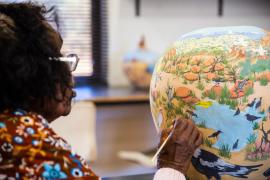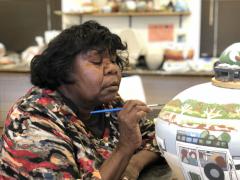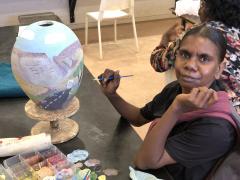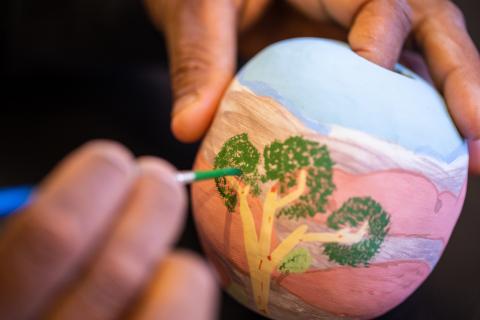It wasn’t until the early 1960s that pottery making was introduced to Arrarnta people by pottery teacher Naomi Sharp. Hermannsburg pottery is an extension of the Mission's and Namatjira's heritage1. Of course, the properties of unfired clay were known to Aboriginal people long before the advent of the mission. Aboriginal people used it in ceremonies for body art and as pigments in rock art amongst other things.
The first systematic attempt to establish an Indigenous cottage industry based on ceramics was led by Victor (Vic) Jaensch (1911-78), a non-Indigenous gardener at the Mission (1957-66). This overlapped with the last years of F.W Albrecht as the lead Lutheran pastor at Hermannsburg
Jaensch had no prior knowledge of ceramics, in the early 1960s he arranged for a local man, Manasse Elatjia (ca. 1905-79), also called Manasse Armstrong by the Mission workers, to take him to Untwaantita, where he intended to excavate the clay pits there to source clay for pottery. The site was well known to senior Western Arrernte men, such as Elatjia, because of ritual and other uses for clay already outlined. Jaensch built a kiln in his backyard with the assistance of Arrernte men Joseph Rontji (1942-) and Nahasson Ungwanaka (1944-90), who later became Lutheran Pastor Ungwanaka. Working with Jaensch, these two men learned to fire small, hand-modelled clay figurines. Because their times at Hermannsburg overlapped by some years... By introducing pottery, Jaensch stumbled upon something that local men enjoyed doing. By the time Jaensch left the settlement in 1966, the idea of a local pottery contributing to this vision had taken hold. 2
Despite this early success nothing seems to have come of the idea of a pottery enterprise once Jaensch let in 1966 until Naomi Sharp, an experience ceramicist arrived in 1990. Sharp's three-week stint at Hermannsburg turned into sixteen years, until her retirement in March 2006.
- Country emerged as a principal theme in the ceramics.
- Everyday scenes from daily life in the small township of Ntaria are often featured.
- The figures on the pot lids often embody something significant to the maker, of historical significance, and/or iconic in nature.
- In recent years there have be nostalgic themes related to the earlier Mission days and aspects of Country, culture and history.
The Hermannsburg potters are now extremely successful and have transformed ceramics into an art form that is unique to Hermannsburg. Visit the Hermannsburg Potters at Kaltajarrinja Street Hermannsburg. For opening hours and more information visit hermannsburgpotters.com.au (Link https:/hermannsburgpotters.com.au/
- Nicholls, Christine. Mission Accomplished: The Hermannsburg Potters Australian and New Zealand Journal of Art; Canberra Vol. 13, Iss. 1, 2013: 126-145,191.
Media










